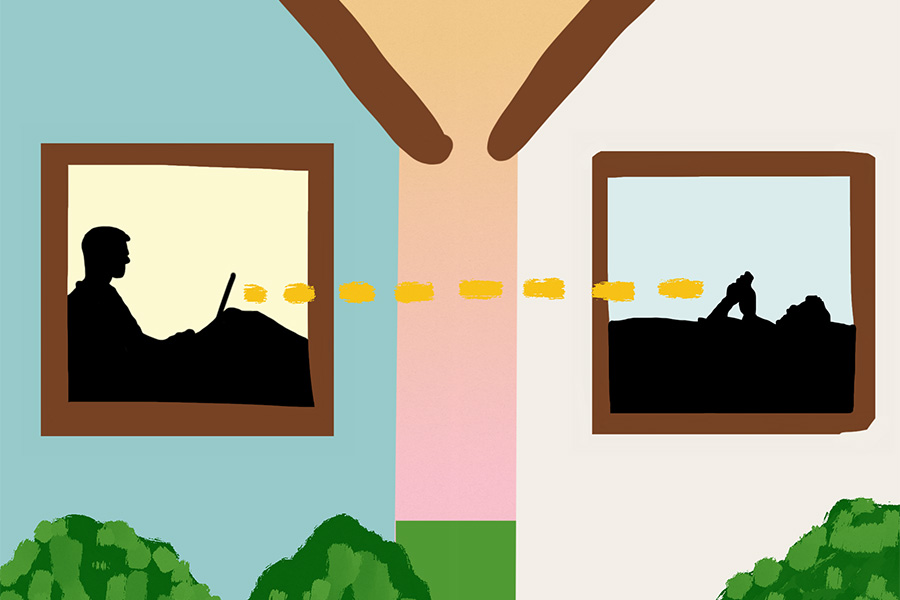Staying Social While Distancing: Students connect digitally during COVID-19
April 18, 2020

Spring athletes stay in touch despite season cancellation
KSHSAA’s decision to cancel all spring sports due to COVID-19 hasn’t stopped athletes from using apps like Zoom and Strava to connect
For spring athletes, especially seniors whose final seasons were canceled due to COVID-19, maintaining a connection as teammates has been increasingly important.
To senior softball player Paige Oliver, connecting with her teammates and friends online has been an important substitute for the team’s daily opportunities to spend time together.
“Not being able to see each other every day has been hard, because normally in the spring we spend every day together,” Oliver said. “Being able to at least FaceTime and text has helped a lot.”
On March 31, days after KSHSAA announced the cancellation of all spring sports, the softball team held their first joint Zoom call. Oliver described how since then, during social distancing and online learning, the team has had to find creative ways to spend time together.
“We use our group chat to talk, and we sometimes do Zoom calls together,” Oliver said. “We also try to do some trunk get-togethers in parking lots to all chat and play catch.”
According to junior track and cross country athlete John Lehan, the cross country and track teams use group Zoom calls to stay in touch as well. Long-distance runners like Lehan have also discovered a new application to stay in touch while they can’t run as a group: Strava.
Strava is a social network for runners that allows teammates to share information about their mileage, routes and pace. They can also post pictures from their runs and add a description, which Lehan says allows each runner to add their own personal touch to the workout. In his opinion, the app has been crucial to keeping the team connected and engaged during social distancing.
“Sharing results with teammates has helped keep everyone accountable and motivated,” Lehan said. “I’ve been especially impressed at the seniors and non-varsity athletes who have continued training. Having diligence across the team shows the strength of our program.”
While Oliver and the softball team don’t have an app tailor-made to coordinate softball practices, she’s still done her best to stay connected with teammates and friends.
“I’ve been doing Zooms, texting my friends and loved ones and saying hi while outside if we happen to cross paths,” Oliver said.
However, despite all the opportunities for online connection and solo workouts across the school’s spring sports teams, Lehan still believes it’s not quite the same as group practices and experiences.
“Practice definitely has a different vibe now,” Lehan said. “Running alone for up to an hour is incredibly boring compared to running in a large pack. We will sometimes bump into one another, but overall, practice doesn’t have the complete team bonding experience.”

Video calling apps allow students to digitally maintain friendships
Stuck at home, students have turned to software like Zoom and FaceTime to spend time with their friends
For many students, Zoom was first introduced as the school’s chosen application for online classes. Now, it’s being used, in addition to FaceTime, as a way for students to maintain personal connections while under quarantine.
Senior Ashley Grega values her ability to communicate with friends; she uses Zoom for virtual group hangouts and FaceTime for talking to a single friend.
“[They] help me to still keep a face-to-face conversation and be semi-normal since we can’t do in person,” Grega said. “Also, over video chats, we can still do normal things like we used to like eat ice cream together, watch TV, play games or even eat [meals] together.”
For Grega, not having these applications would be “mentally draining” because seeing her friends’ faces, in addition to their voices, makes their communication more real. However, she has also made the effort to think outside of the box in how she communicates.
“I have been writing letters because sometimes you want to spice things up and do something different to keep in touch,” Grega said. “Plus, it’s so exciting to get a letter in the mail from someone.”
For freshman Brianna Coup, face-to-face interaction is important even beyond communication – she’s been able to make workouts out home more enjoyable by doing them along with her friends via Zoom.
Having this interaction with friends makes being home 24/7 more bearable for Coup, who believes that communication is necessary for getting through the stay-at-home order.
“Without communication, life would be super boring and I would have nothing to do,” Coup said. “Being inside is already driving everyone crazy and without being able to at least communicate with their friends, people [would] start to violate the lockdown.”
The school’s debaters have also utilized Zoom to not only maintain their relationship as a team but actively continue practice and competition. For freshman Sarah Johnston, participating in weekly practice debates via Zoom has been a fun way to strengthen the bond between team members.
“Participating in online practice debates with our debate team has been a really fun and unique experience. It allows our team to still feel connected despite quarantine and get our practice in, which is necessary for growth,” Johnston said. “Having a wide array of technological options to communicate with each other keeps the whole team aspect strong.”
The team is even maintaining a presence in the debate community by partaking in online tournaments. Johnston and junior Adam White competed in the Georgetown Spring International Tournament, an online competition that hosted competitors from all around the world.
“It was a blast, but the best part was that we were able to strengthen our debate skills right from our homes,” Johnston said. “Using Zoom has allowed us to still communicate with one another while also participating in activities that bring a sense of normalcy to the whole situation.”

Students and clubs employ social media to bond during social distancing
Social media apps like Instagram, Snapchat and TikTok foster student and club activities
Social media, which was already prominent in the lives of many students before the COVID-19 outbreak, has become a staple of student interaction without the opportunity to spend time together in person. Apps like Instagram, TikTok and Snapchat and their social features have allowed both individual students and clubs like JLC and StuCo to create unique group activities.
For junior Katherine Weigel, social media is a source of both news and entertainment during social distancing.
“[Social media] lets my friends and I still laugh during these uncertain times and they keep us up to date on the latest things,” Weigel said. “On TikTok, you can also duet dances with friends, and it is kind of like you are there dancing with them.”
Senior Ashley Grega uses social media mostly to laugh with her friends and remember sentimental moments.
““I send [my friends] funny videos or memes on Instagram or Snapchat,” Grega said. “I like to post on my finsta with old videos or photos of us and tag them to say I miss them.”
Grega, who is a member of JLC, says that the club has been working with StuCo to develop ways to keep students in touch via social media during the absence of at-school activities.
“StuCo created a group to help spread positivity during quarantine and asked to expand it to members of JLC. I’m a part of JLC and I wanted to join, so I did,” Grega said. “We have had a few Zoom meetings to think of ideas on live streams or spirit weeks or playing bingo that we can all post on our [Instagram] stories to keep everyone connected by showing pictures.”
Senior student body president Annie Bogart was instrumental to developing StuCo’s first social media spirit week. In an earlier interview, Bogart explained why she believes using social media to bring the student body together is so important.
“Other organizations, student leaders and myself have an obligation to the student body,” Bogart said. “We will not let the year end without closure and will do everything in our power to promote spirit.”
StuCo’s social media spirit week activities have included live guitar with physics teacher Chad Brown and meditation sessions with English teacher Coral Brignoni via Instagram Live.
According to senior Avery Altman, seeing students and teachers use social media to stay connected is comforting and develops community.
“Giving teachers a platform to reach their students, like with Breathing with Brig, is important,” Altman said. “Seeing everyone participating in the activities we plan out is a sense of comfort and connection even when we all feel so isolated.”

